【2024年中考英语二轮复习讲练测(全国通用)】专题14 语法选择(真题解析+考点提炼课件)
文档属性
| 名称 | 【2024年中考英语二轮复习讲练测(全国通用)】专题14 语法选择(真题解析+考点提炼课件) |  | |
| 格式 | pptx | ||
| 文件大小 | 4.7MB | ||
| 资源类型 | 试卷 | ||
| 版本资源 | 通用版 | ||
| 科目 | 英语 | ||
| 更新时间 | 2024-04-04 10:08:18 | ||
图片预览

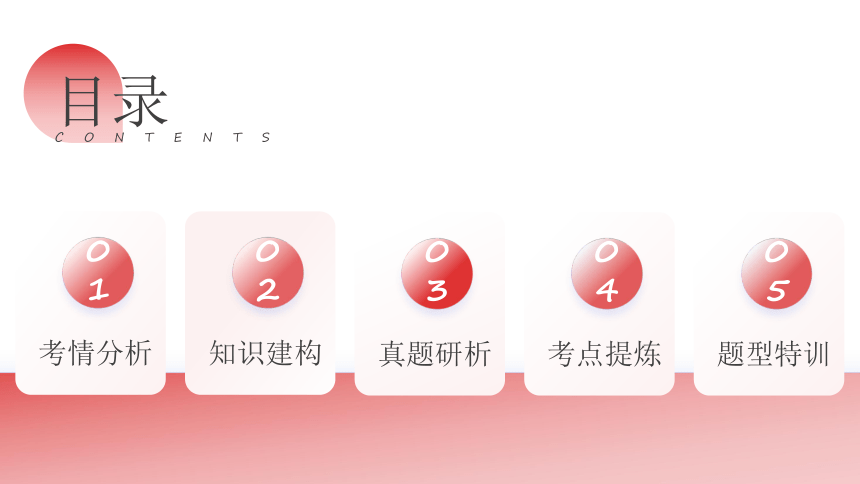
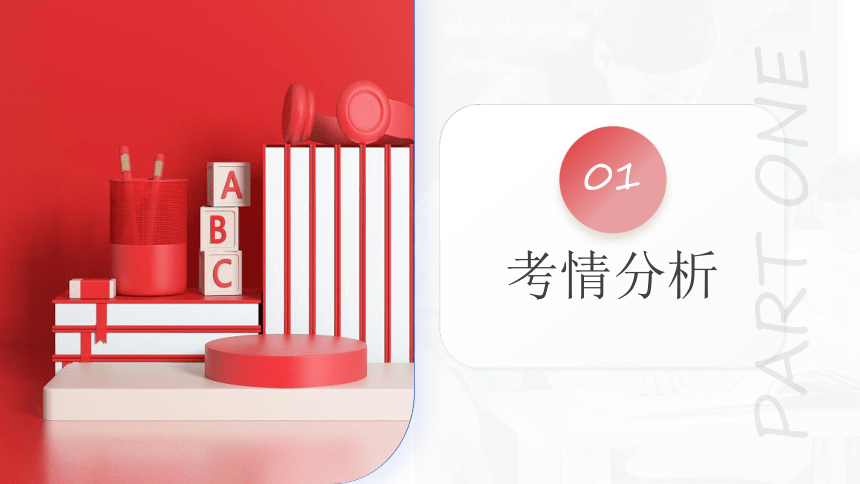
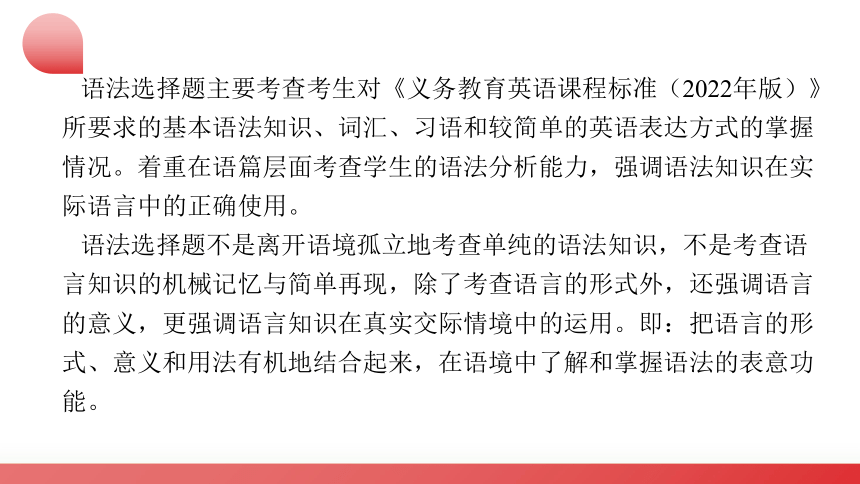
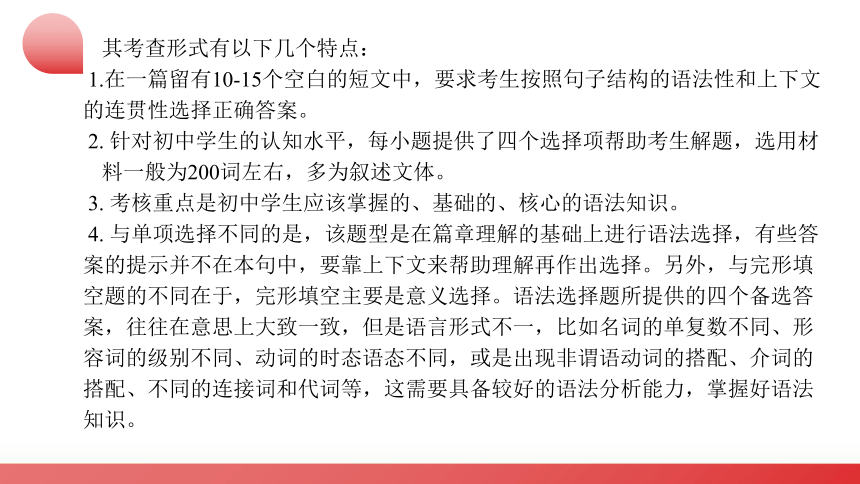

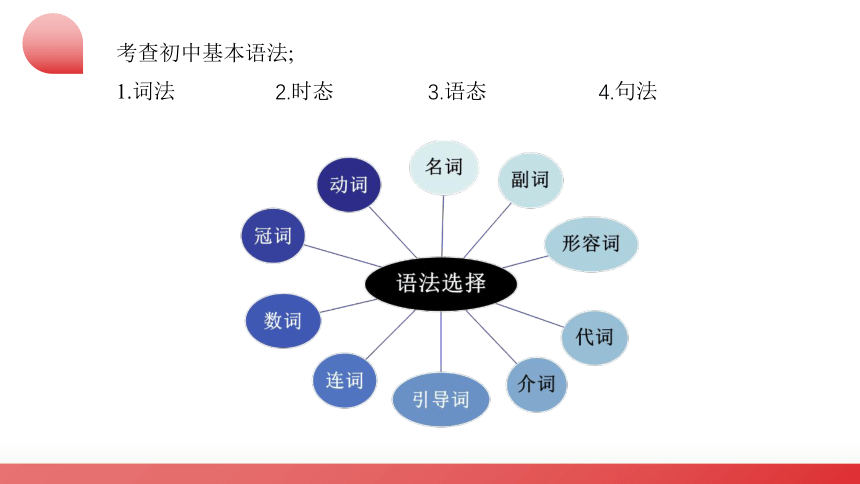

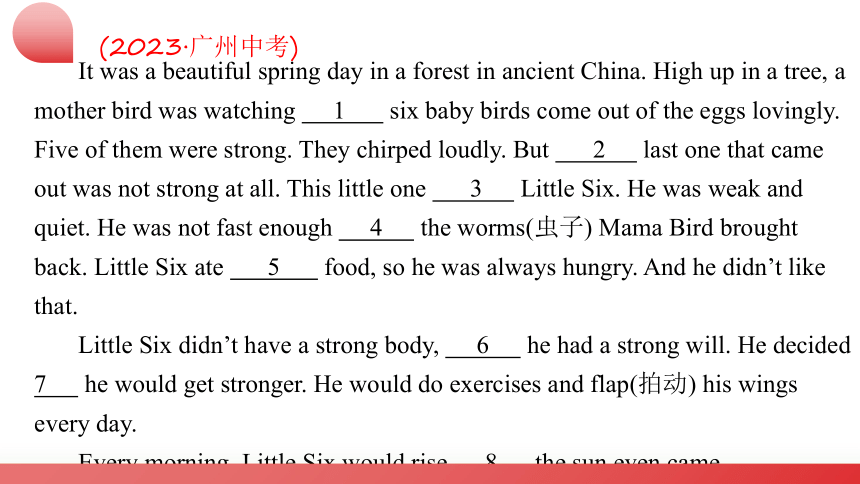
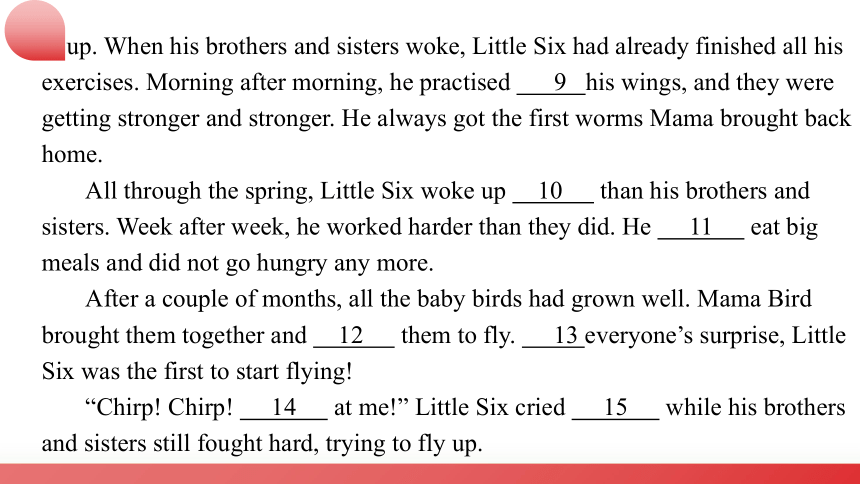

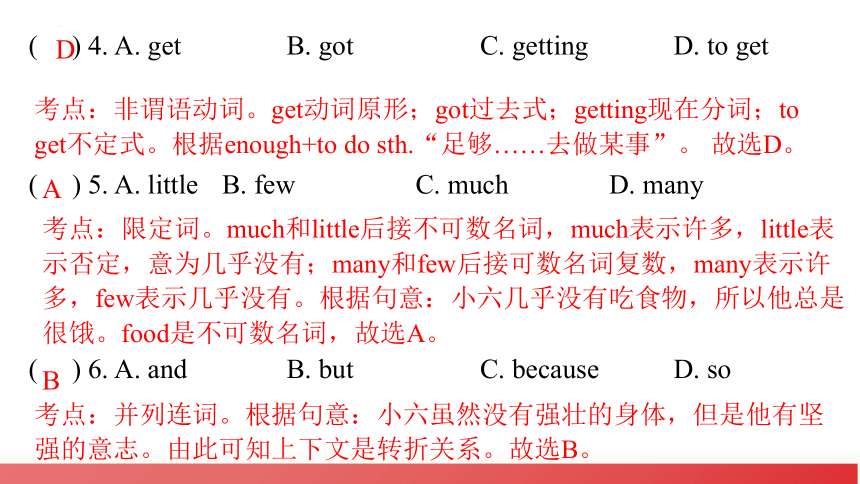
文档简介
(共36张PPT)
导师:稻壳儿
二轮复习讲练测
第十四讲:语法选择
01
考情分析
02
知识建构
03
真题研析
04
考点提炼
目录
CONTENTS
05
题型特训
01
考情分析
PART ONE
语法选择题主要考查考生对《义务教育英语课程标准(2022年版)》所要求的基本语法知识、词汇、习语和较简单的英语表达方式的掌握情况。着重在语篇层面考查学生的语法分析能力,强调语法知识在实际语言中的正确使用。
语法选择题不是离开语境孤立地考查单纯的语法知识,不是考查语言知识的机械记忆与简单再现,除了考查语言的形式外,还强调语言的意义,更强调语言知识在真实交际情境中的运用。即:把语言的形式、意义和用法有机地结合起来,在语境中了解和掌握语法的表意功能。
其考查形式有以下几个特点:
1.在一篇留有10-15个空白的短文中,要求考生按照句子结构的语法性和上下文的连贯性选择正确答案。
2. 针对初中学生的认知水平,每小题提供了四个选择项帮助考生解题,选用材料一般为200词左右,多为叙述文体。
3. 考核重点是初中学生应该掌握的、基础的、核心的语法知识。
4. 与单项选择不同的是,该题型是在篇章理解的基础上进行语法选择,有些答案的提示并不在本句中,要靠上下文来帮助理解再作出选择。另外,与完形填空题的不同在于,完形填空主要是意义选择。语法选择题所提供的四个备选答案,往往在意思上大致一致,但是语言形式不一,比如名词的单复数不同、形容词的级别不同、动词的时态语态不同,或是出现非谓语动词的搭配、介词的搭配、不同的连接词和代词等,这需要具备较好的语法分析能力,掌握好语法知识。
02
知识构建
PART TWO
考查初中基本语法;
1.词法 2.时态 3.语态 4.句法
03
真题研析
PART THREE
It was a beautiful spring day in a forest in ancient China. High up in a tree, a mother bird was watching 1 six baby birds come out of the eggs lovingly. Five of them were strong. They chirped loudly. But 2 last one that came out was not strong at all. This little one 3 Little Six. He was weak and quiet. He was not fast enough 4 the worms(虫子) Mama Bird brought back. Little Six ate 5 food, so he was always hungry. And he didn’t like that.
Little Six didn’t have a strong body, 6 he had a strong will. He decided 7 he would get stronger. He would do exercises and flap(拍动) his wings every day.
Every morning, Little Six would rise 8 the sun even came
(2023·广州中考)
up. When his brothers and sisters woke, Little Six had already finished all his exercises. Morning after morning, he practised 9 his wings, and they were getting stronger and stronger. He always got the first worms Mama brought back home.
All through the spring, Little Six woke up 10 than his brothers and sisters. Week after week, he worked harder than they did. He 11 eat big meals and did not go hungry any more.
After a couple of months, all the baby birds had grown well. Mama Bird brought them together and 12 them to fly. 13 everyone’s surprise, Little Six was the first to start flying!
“Chirp! Chirp! 14 at me!” Little Six cried 15 while his brothers and sisters still fought hard, trying to fly up.
( ) 1. A. she B. her C. hers D. herself
( ) 2. A. a B. an C. the D. /
( ) 3. A. called B. was calling C. was called D. were called
B
考点:形容词性物主代词。she她,主格;her她的,形容词性物主代词;hers她的,名词性物主代词;herself她自己,反身代词。six baby birds中心词是名词birds,因此前面有形容词性物主代词修饰限定。故选B。
C
考点:冠词。此处特指最后一只小鸟,用the。故选C。
C
考点:被动语态。最后一只小鸟被叫做Little Six(小六)。故选C。
( ) 4. A. get B. got C. getting D. to get
( ) 5. A. little B. few C. much D. many
( ) 6. A. and B. but C. because D. so
D
考点:非谓语动词。get动词原形;got过去式;getting现在分词;to get不定式。根据enough+to do sth.“足够……去做某事”。 故选D。
A
考点:限定词。much和little后接不可数名词,much表示许多,little表示否定,意为几乎没有;many和few后接可数名词复数,many表示许多,few表示几乎没有。根据句意:小六几乎没有吃食物,所以他总是很饿。food是不可数名词,故选A。
B
考点:并列连词。根据句意:小六虽然没有强壮的身体,但是他有坚强的意志。由此可知上下文是转折关系。故选B。
( ) 7. A. what B. why C. when D. that
( ) 8. A. before B. after C. until D. if
( ) 9. A. flap B. to flap C. flapping D. flapped
D
考点:宾语从句。what什么;why为什么;when什么时候;that那个,引导宾语从句无实意。根据句意:他决定变得更强。he would get stronger是陈述句,用that引导。故选D。
A
考点:状语从句。before 之前;after之后;until直到;if如果。根据句意:每天早上,小六在太阳升起之前起床。故选A。
C
考点:非谓语动词。practise doing sth. 表示练习做某事。故选C。
( ) 10. A. early B. earlier C. earliest D. the earliest
( ) 11. A. could B. might C. should D. must
( ) 12. A. teach B. teaches C. taught D. will teach
B
考点:副词比较级。early早,副词原形;earlier比较级;earliest最高级;the earliest最高级。根据关键词than可知是比较级。故选B。
A
考点:情态动词。could能够;might可能;should应该;must必须。根据句意:他能够吃到大餐,再也没有挨饿了。故选A。
C
考点:时态。teach动词原形;teaches第三人称单数形式;taught过去式;will teach一般将来时。and是并列连词,brought是过去式。故选C。
( ) 13. A. In B. To C. For D. At
( ) 14. A. Look B. Looks C. To look D. Looking
( ) 15. A. happy B. happier C. happiness D. happily
B
考点:介词。to one’s surprise表示令某人吃惊的是。故选B。
A
考点:祈使句。根据句子结构可知此处是祈使句,以动词原形开头。故选A。
D
考点:副词。happy开心的,形容词原级;happier更开心的,形容词比较级;happiness名词;happily开心地,副词。该处用副词形式修饰cried。故选D。
04
考点提炼
PART FOUR
主要从动词的时态、语态、非谓语动词、介词+Ving、情态动词+动词原形等方面考查。
动词
一看→有无时态标志
二看→空格前有无情态动词、介词 (情态动词+动原;介词+Ving)
三看→有无and/or (and/or前或后的动词形式要一致)
四看→选项出现被动语态,则判断主语与动词是主动还是被动
五看→ 注意非谓语动词搭配,如 spend + Ving
宾语从句:根据宾语从句所缺意思选择引导词that,
whether, if,wh-疑问词
定语从句:判断定语从句修饰的是人或物,修饰人用
who或 that,修饰物用which或that
状语从句:时间状语用when, as或while,条件状语用if
或whether,原因状语用because, since或as,
结果状语用so,so/ such… that等。
从句引导词
主要考查冠词a, an, the的选用,一般元音音标前用an,辅音音标前用a,文章特指或第二次提及用the。
冠词
考查频率最高的是but、so、or、and、although、though、both、either、neither、all的用法。判断文章前后的逻辑关系即可较容易选对答案。
连词
but:表示转折关系;
so:表示因果关系;
or:或者、否则之意;
and:表示并列关系;
though/although:表示虽然……但是,不能与but连用。
both...and:表示两者都;
either...or:表示两者之一;
neither...nor:表示两者中没有一个;
all:表示全部都,用于三者以上。
主要考查基数词和序数词的用法,以及“具体数词+ hundred, thousand, million”和“hundreds, thousands, millions + of”的使用。
数词
1. 考查分词作形容词,-ed是修饰人,-ing是修饰物
2. 考查系动词+形容词
3. 考查形容词原级、比较级、最高级
形容词
主要考查固定搭配。频率最高的介词:on、in、at、for用在时间前的用法,with、without的用法。
介词
at: 用于具体时刻、传统节日前,例如:at 8:00,at Christmas. 固定搭配:at noon, at night
in: 用于世纪、年、季节、月等不具体的时间前,例如:in 2011
固定搭配:in the morning/afternoon/evening
on: 用于具体的某一天,或具体的早上、下午、晚上。
for: 后面+一段时间,现在完成时的标志
with: 与...一起,和...;带着...,有...的;以(手段、材料),用(工具)
without: 没有。
主要从可数名词单复数、可数或不可数的判断以及所有格的用法。
名词
副词
考查副词的基本用法之一——修饰动词,在该句子中,空格前有动词,则要用副词修饰。
考查人称代词、反身代词、不定代词等的运用。
代词
1)人称代词——动词/介词后用宾格;
2)空格后有名词,用形容词所有格,没有名词则用名词所有格;
3)反身代词常考——enjoy oneself / help yourself / dress oneself / teach oneself;
4)不定代词something、everything、anything、nothing——被形
容词修饰时,形容词后置;
5)other、the other、others、the others——other、the other分别为“其他的”、“其余的”的意思,后面跟名词,others、the others分别为“其他人/东西”、“其余的人/东西”,已经是名词。有the,说明是在一定范围内。
Step 1
读第一句话→动词→判断时态→为做题时选动词找依据
Step 2
以句为单位→找提示词 →确定考点
Step 3
代入答案→核实准确性
解题步骤
05
题型特训
PART FIVE
When I was nine years old, I wanted to keep a pet fish. After months of 1 , I finally had enough money to get one. I named it Bob. I put 2 beautiful toy house with windows in the tank(鱼缸) so that Bob could swim through. Sometimes, I would draw pictures of 3 fish and sea plants and tape them to the side of the tank, so Bob wouldn’t get lonely while I 4 at school.
However, 5 a month, I noticed that the tank was getting dirty. My dad asked me 6 it into the kitchen. He wanted to make sure I knew 7 to do so that Bob wouldn’t get hurt.
First, my dad told me to reach 8 into the tank and take the house away. 9 I took my hand out of the water, I noticed
(2022·广州中考)
that the water was a lot 10 than I thought.
“That’s smelly!” I said. “Let’s hurry up and 11 the fish out of the water, Dad!”
“Not so fast, Ben,” Dad said. “We need to save some of the old water, 12 Bob needs a place to stay while we clean the tank.”
“Why ” I asked.
“Running water from the tap can be harmful to fish,” Dad explained. “That 13 we can’t put Bob into fresh water right away. Instead, we need to put him in a cup with 14 of the dirty water for a while.”...
All seemed so easy. I hoped the next time I would be able to clean the tank all by 15 .
( ) 1. A. save B. saves C. saved D. saving
( ) 2. A. a B. an C. the D. /
( ) 3. A. other B. others C. the other D. the others
D
考点:非谓语动词。of 是介词,介词后要用动词doing形式。故选D。
A
考点:冠词。这里是第一次提到而且意思是一个,beautiful是以辅音发音开头。故选A。
A
考点:不定代词。other是其他的,后面加名词复数,对应题目的fish and sea plants。others是其他的事物,其后不加名词。the other是两者中的另一个或者是有范围的剩下的其他的。the others是有范围的剩下的其他的事物。故选A。
( ) 4. A. am B. was C. were D. will be
( ) 5. A. before B. for C. after D. during
( ) 6. A. bring B. bringing C. brought D. to bring
B
考点:时态。根据全文和前面的wouldn’t可以知道这里应该用的是过去式。故选B。
C
考点:介词。题意可知这里说的是然而一个月之后,我注意到这个水缸变脏了。after之后,符合题意;before之前;for 作为,因为;during 在……期间。故选C。
D
考点:非谓语动词。根据ask sb. to do sth.。故选D。
( ) 7. A. where B. what C. how D. why
( ) 8. A. care B. careful C. carefully D. caring
( ) 9. A. If B. Unless C. When D. Though
B
考点:宾语从句。根据句意:父亲想要确保我知道要做什么Bob才不会受伤。故选B。
C
考点:副词。根据题目可知前面有动词reach,用副词carefully去修饰reach。故选C。
C
考点:状语从句。根据题意:当我把手拿出水时,我注意到水比我想象的还要脏。when是当……的时候;if 如果;unless除非;though尽管。故选C。
( ) 10. A. dirty B. dirtier C. dirtiest D. the dirtiest
( ) 11. A. get B. gets C. got D. getting
( ) 12. A. so B. or C. because D. but
B
考点:形容词比较级。than是形容词比较级的标志词。故选B。
A
考点:非谓语动词。Let’s是祈使句的一个句式,意思是“让我们……”, 后面接动词原形。故选A。
C
考点:并列连词。根据题意:父亲说我们需要保留一些原来的水,Bob在我们清洁水缸时需要一个地方待着。这里构成因果关系。故选C。
( ) 13. A. mean B. means C. meant D. is meaning
( ) 14. A. few B. a few C. little D. a little
( ) 15. A. me B. my C. mine D. myself
B
考点:时态。根据句中can’t可知用一般现在时,主语是That,需用第三人称单数形式。故选B。
D
考点:数词。few 很少,几乎没有;a few 有一些,两者都是修饰可数名词。little 很少;a little,有一些,修饰不可数名词。题中water不可数,且表示肯定意义,用a little限定。故选D。
D
考点:反身代词。by oneself 表示某人自己。根据题意可知作者说整个过程似乎看起来很简单,希望下次可以自己清洁鱼缸。故选D。
感谢观看
THANK YOU
导师:稻壳儿
二轮复习讲练测
第十四讲:语法选择
01
考情分析
02
知识建构
03
真题研析
04
考点提炼
目录
CONTENTS
05
题型特训
01
考情分析
PART ONE
语法选择题主要考查考生对《义务教育英语课程标准(2022年版)》所要求的基本语法知识、词汇、习语和较简单的英语表达方式的掌握情况。着重在语篇层面考查学生的语法分析能力,强调语法知识在实际语言中的正确使用。
语法选择题不是离开语境孤立地考查单纯的语法知识,不是考查语言知识的机械记忆与简单再现,除了考查语言的形式外,还强调语言的意义,更强调语言知识在真实交际情境中的运用。即:把语言的形式、意义和用法有机地结合起来,在语境中了解和掌握语法的表意功能。
其考查形式有以下几个特点:
1.在一篇留有10-15个空白的短文中,要求考生按照句子结构的语法性和上下文的连贯性选择正确答案。
2. 针对初中学生的认知水平,每小题提供了四个选择项帮助考生解题,选用材料一般为200词左右,多为叙述文体。
3. 考核重点是初中学生应该掌握的、基础的、核心的语法知识。
4. 与单项选择不同的是,该题型是在篇章理解的基础上进行语法选择,有些答案的提示并不在本句中,要靠上下文来帮助理解再作出选择。另外,与完形填空题的不同在于,完形填空主要是意义选择。语法选择题所提供的四个备选答案,往往在意思上大致一致,但是语言形式不一,比如名词的单复数不同、形容词的级别不同、动词的时态语态不同,或是出现非谓语动词的搭配、介词的搭配、不同的连接词和代词等,这需要具备较好的语法分析能力,掌握好语法知识。
02
知识构建
PART TWO
考查初中基本语法;
1.词法 2.时态 3.语态 4.句法
03
真题研析
PART THREE
It was a beautiful spring day in a forest in ancient China. High up in a tree, a mother bird was watching 1 six baby birds come out of the eggs lovingly. Five of them were strong. They chirped loudly. But 2 last one that came out was not strong at all. This little one 3 Little Six. He was weak and quiet. He was not fast enough 4 the worms(虫子) Mama Bird brought back. Little Six ate 5 food, so he was always hungry. And he didn’t like that.
Little Six didn’t have a strong body, 6 he had a strong will. He decided 7 he would get stronger. He would do exercises and flap(拍动) his wings every day.
Every morning, Little Six would rise 8 the sun even came
(2023·广州中考)
up. When his brothers and sisters woke, Little Six had already finished all his exercises. Morning after morning, he practised 9 his wings, and they were getting stronger and stronger. He always got the first worms Mama brought back home.
All through the spring, Little Six woke up 10 than his brothers and sisters. Week after week, he worked harder than they did. He 11 eat big meals and did not go hungry any more.
After a couple of months, all the baby birds had grown well. Mama Bird brought them together and 12 them to fly. 13 everyone’s surprise, Little Six was the first to start flying!
“Chirp! Chirp! 14 at me!” Little Six cried 15 while his brothers and sisters still fought hard, trying to fly up.
( ) 1. A. she B. her C. hers D. herself
( ) 2. A. a B. an C. the D. /
( ) 3. A. called B. was calling C. was called D. were called
B
考点:形容词性物主代词。she她,主格;her她的,形容词性物主代词;hers她的,名词性物主代词;herself她自己,反身代词。six baby birds中心词是名词birds,因此前面有形容词性物主代词修饰限定。故选B。
C
考点:冠词。此处特指最后一只小鸟,用the。故选C。
C
考点:被动语态。最后一只小鸟被叫做Little Six(小六)。故选C。
( ) 4. A. get B. got C. getting D. to get
( ) 5. A. little B. few C. much D. many
( ) 6. A. and B. but C. because D. so
D
考点:非谓语动词。get动词原形;got过去式;getting现在分词;to get不定式。根据enough+to do sth.“足够……去做某事”。 故选D。
A
考点:限定词。much和little后接不可数名词,much表示许多,little表示否定,意为几乎没有;many和few后接可数名词复数,many表示许多,few表示几乎没有。根据句意:小六几乎没有吃食物,所以他总是很饿。food是不可数名词,故选A。
B
考点:并列连词。根据句意:小六虽然没有强壮的身体,但是他有坚强的意志。由此可知上下文是转折关系。故选B。
( ) 7. A. what B. why C. when D. that
( ) 8. A. before B. after C. until D. if
( ) 9. A. flap B. to flap C. flapping D. flapped
D
考点:宾语从句。what什么;why为什么;when什么时候;that那个,引导宾语从句无实意。根据句意:他决定变得更强。he would get stronger是陈述句,用that引导。故选D。
A
考点:状语从句。before 之前;after之后;until直到;if如果。根据句意:每天早上,小六在太阳升起之前起床。故选A。
C
考点:非谓语动词。practise doing sth. 表示练习做某事。故选C。
( ) 10. A. early B. earlier C. earliest D. the earliest
( ) 11. A. could B. might C. should D. must
( ) 12. A. teach B. teaches C. taught D. will teach
B
考点:副词比较级。early早,副词原形;earlier比较级;earliest最高级;the earliest最高级。根据关键词than可知是比较级。故选B。
A
考点:情态动词。could能够;might可能;should应该;must必须。根据句意:他能够吃到大餐,再也没有挨饿了。故选A。
C
考点:时态。teach动词原形;teaches第三人称单数形式;taught过去式;will teach一般将来时。and是并列连词,brought是过去式。故选C。
( ) 13. A. In B. To C. For D. At
( ) 14. A. Look B. Looks C. To look D. Looking
( ) 15. A. happy B. happier C. happiness D. happily
B
考点:介词。to one’s surprise表示令某人吃惊的是。故选B。
A
考点:祈使句。根据句子结构可知此处是祈使句,以动词原形开头。故选A。
D
考点:副词。happy开心的,形容词原级;happier更开心的,形容词比较级;happiness名词;happily开心地,副词。该处用副词形式修饰cried。故选D。
04
考点提炼
PART FOUR
主要从动词的时态、语态、非谓语动词、介词+Ving、情态动词+动词原形等方面考查。
动词
一看→有无时态标志
二看→空格前有无情态动词、介词 (情态动词+动原;介词+Ving)
三看→有无and/or (and/or前或后的动词形式要一致)
四看→选项出现被动语态,则判断主语与动词是主动还是被动
五看→ 注意非谓语动词搭配,如 spend + Ving
宾语从句:根据宾语从句所缺意思选择引导词that,
whether, if,wh-疑问词
定语从句:判断定语从句修饰的是人或物,修饰人用
who或 that,修饰物用which或that
状语从句:时间状语用when, as或while,条件状语用if
或whether,原因状语用because, since或as,
结果状语用so,so/ such… that等。
从句引导词
主要考查冠词a, an, the的选用,一般元音音标前用an,辅音音标前用a,文章特指或第二次提及用the。
冠词
考查频率最高的是but、so、or、and、although、though、both、either、neither、all的用法。判断文章前后的逻辑关系即可较容易选对答案。
连词
but:表示转折关系;
so:表示因果关系;
or:或者、否则之意;
and:表示并列关系;
though/although:表示虽然……但是,不能与but连用。
both...and:表示两者都;
either...or:表示两者之一;
neither...nor:表示两者中没有一个;
all:表示全部都,用于三者以上。
主要考查基数词和序数词的用法,以及“具体数词+ hundred, thousand, million”和“hundreds, thousands, millions + of”的使用。
数词
1. 考查分词作形容词,-ed是修饰人,-ing是修饰物
2. 考查系动词+形容词
3. 考查形容词原级、比较级、最高级
形容词
主要考查固定搭配。频率最高的介词:on、in、at、for用在时间前的用法,with、without的用法。
介词
at: 用于具体时刻、传统节日前,例如:at 8:00,at Christmas. 固定搭配:at noon, at night
in: 用于世纪、年、季节、月等不具体的时间前,例如:in 2011
固定搭配:in the morning/afternoon/evening
on: 用于具体的某一天,或具体的早上、下午、晚上。
for: 后面+一段时间,现在完成时的标志
with: 与...一起,和...;带着...,有...的;以(手段、材料),用(工具)
without: 没有。
主要从可数名词单复数、可数或不可数的判断以及所有格的用法。
名词
副词
考查副词的基本用法之一——修饰动词,在该句子中,空格前有动词,则要用副词修饰。
考查人称代词、反身代词、不定代词等的运用。
代词
1)人称代词——动词/介词后用宾格;
2)空格后有名词,用形容词所有格,没有名词则用名词所有格;
3)反身代词常考——enjoy oneself / help yourself / dress oneself / teach oneself;
4)不定代词something、everything、anything、nothing——被形
容词修饰时,形容词后置;
5)other、the other、others、the others——other、the other分别为“其他的”、“其余的”的意思,后面跟名词,others、the others分别为“其他人/东西”、“其余的人/东西”,已经是名词。有the,说明是在一定范围内。
Step 1
读第一句话→动词→判断时态→为做题时选动词找依据
Step 2
以句为单位→找提示词 →确定考点
Step 3
代入答案→核实准确性
解题步骤
05
题型特训
PART FIVE
When I was nine years old, I wanted to keep a pet fish. After months of 1 , I finally had enough money to get one. I named it Bob. I put 2 beautiful toy house with windows in the tank(鱼缸) so that Bob could swim through. Sometimes, I would draw pictures of 3 fish and sea plants and tape them to the side of the tank, so Bob wouldn’t get lonely while I 4 at school.
However, 5 a month, I noticed that the tank was getting dirty. My dad asked me 6 it into the kitchen. He wanted to make sure I knew 7 to do so that Bob wouldn’t get hurt.
First, my dad told me to reach 8 into the tank and take the house away. 9 I took my hand out of the water, I noticed
(2022·广州中考)
that the water was a lot 10 than I thought.
“That’s smelly!” I said. “Let’s hurry up and 11 the fish out of the water, Dad!”
“Not so fast, Ben,” Dad said. “We need to save some of the old water, 12 Bob needs a place to stay while we clean the tank.”
“Why ” I asked.
“Running water from the tap can be harmful to fish,” Dad explained. “That 13 we can’t put Bob into fresh water right away. Instead, we need to put him in a cup with 14 of the dirty water for a while.”...
All seemed so easy. I hoped the next time I would be able to clean the tank all by 15 .
( ) 1. A. save B. saves C. saved D. saving
( ) 2. A. a B. an C. the D. /
( ) 3. A. other B. others C. the other D. the others
D
考点:非谓语动词。of 是介词,介词后要用动词doing形式。故选D。
A
考点:冠词。这里是第一次提到而且意思是一个,beautiful是以辅音发音开头。故选A。
A
考点:不定代词。other是其他的,后面加名词复数,对应题目的fish and sea plants。others是其他的事物,其后不加名词。the other是两者中的另一个或者是有范围的剩下的其他的。the others是有范围的剩下的其他的事物。故选A。
( ) 4. A. am B. was C. were D. will be
( ) 5. A. before B. for C. after D. during
( ) 6. A. bring B. bringing C. brought D. to bring
B
考点:时态。根据全文和前面的wouldn’t可以知道这里应该用的是过去式。故选B。
C
考点:介词。题意可知这里说的是然而一个月之后,我注意到这个水缸变脏了。after之后,符合题意;before之前;for 作为,因为;during 在……期间。故选C。
D
考点:非谓语动词。根据ask sb. to do sth.。故选D。
( ) 7. A. where B. what C. how D. why
( ) 8. A. care B. careful C. carefully D. caring
( ) 9. A. If B. Unless C. When D. Though
B
考点:宾语从句。根据句意:父亲想要确保我知道要做什么Bob才不会受伤。故选B。
C
考点:副词。根据题目可知前面有动词reach,用副词carefully去修饰reach。故选C。
C
考点:状语从句。根据题意:当我把手拿出水时,我注意到水比我想象的还要脏。when是当……的时候;if 如果;unless除非;though尽管。故选C。
( ) 10. A. dirty B. dirtier C. dirtiest D. the dirtiest
( ) 11. A. get B. gets C. got D. getting
( ) 12. A. so B. or C. because D. but
B
考点:形容词比较级。than是形容词比较级的标志词。故选B。
A
考点:非谓语动词。Let’s是祈使句的一个句式,意思是“让我们……”, 后面接动词原形。故选A。
C
考点:并列连词。根据题意:父亲说我们需要保留一些原来的水,Bob在我们清洁水缸时需要一个地方待着。这里构成因果关系。故选C。
( ) 13. A. mean B. means C. meant D. is meaning
( ) 14. A. few B. a few C. little D. a little
( ) 15. A. me B. my C. mine D. myself
B
考点:时态。根据句中can’t可知用一般现在时,主语是That,需用第三人称单数形式。故选B。
D
考点:数词。few 很少,几乎没有;a few 有一些,两者都是修饰可数名词。little 很少;a little,有一些,修饰不可数名词。题中water不可数,且表示肯定意义,用a little限定。故选D。
D
考点:反身代词。by oneself 表示某人自己。根据题意可知作者说整个过程似乎看起来很简单,希望下次可以自己清洁鱼缸。故选D。
感谢观看
THANK YOU
同课章节目录
- 词法
- 名词
- 动词和动词短语
- 动词语态
- 动词时态
- 助动词和情态动词
- 非谓语动词
- 冠词
- 代词
- 数词和量词
- 形容词副词及其比较等级
- 介词和介词短语
- 连词和感叹词
- 构词法
- 相似、相近词比较
- 句法
- 陈述句
- 一般疑问句和否定疑问句
- 特殊疑问句及选择疑问句
- 反意疑问句
- 存在句(There be句型)
- 宾语从句
- 定语从句
- 状语从句
- 主谓一致问题
- 简单句
- 并列句
- 复合句
- 主谓一致
- 主、表语从句
- 名词性从句
- 直接引语和间接引语
- 虚拟语气
- 感叹句
- 强调句
- 倒装句
- 祈使句
- 句子的成分
- 句子的分类
- 题型专区
- 单项选择部分
- 易错题
- 完形填空
- 阅读理解
- 词汇练习
- 听说训练
- 句型转换
- 补全对话
- 短文改错
- 翻译
- 书面表达
- 任务型阅读
- 语法填空
- 其他资料
